- Fuel
- Any material substance that can be consumed to supply heat or power. Included are petroleum (gasoline and diesel), coal, and natural gas (CNG, LPG), and other consumable materials, such as uranium, biomass, and hydrogen.
- A material used to create heat or power through chemical conversion in processes such as burning or electrochemistry.
- A combustible material used to produce energy. One of the essential factors in a Combustion engine(Fuel, Air, Proper proportion of mixture, compression, timing, spark).
See- Air And Fuel
- air-fuel ratio
- Alcohol Fuel
- Alternative Fuel
- Aviation fuel
- Boiler Fuel
- Bunker Fuels
- Ceramic Fuel
- Clean Fuel
- Deceleration fuel cut-off
- Diesel fuel
- Domestic Fuel
- Early fuel evaporation system
- Electric fuel pump
- Electronic fuel injection
- EPA fuel economy
- in-line fuel filter
- Injection Fuel
- integral fuel filter
- Jet Fuel
- Kerosene Jet Fuel
- L-jetronic fuel injection system
- Low fuel indicator
- Low Sulfur Diesel Fuel
- Naphtha-Type Jet Fuel
- Near Neat Fuel
- Neat Alcohol Fuel
- Neat Fuel
- Nonrenewable Fuels
- Number One Diesel Fuel
- Number Two Diesel Fuel
- Oxygenated Fuel
- Petroleum Fuel
- Port fuel injection
- Primary Fuels
- Process Fuel
- Proper proportion of air and fuel
- Refinery Fuel
- Temporarily Discharged Fuel
- Ultra-Low Sulfur Diesel Fuel
- Fuel accumulator
- A device in the K-Jetronicfuel injection system which serves to absorb the initial pressure surge when afuel pump starts
- A diaphragm unit which helps maintain residual fuel pressure for hot starting on CIS type fuel system
- Fuel additive
- A chemical preparation which is added to fuel to improve and maintain its properties. Detergents and corrosion inhibitors are examples of gasoline additives.
- Fuel advance system
- Advances fuel delivery during cold starts on GM vehicle. Consists of a thermal-sensitive Solenoid on the intake manifold which sends a signal to the HPCA terminal, which opens a ball-check valve on top of the injection pump housing. With pump housing pressure reduced, the timing mechanism has less resistance to overcome and operates earlier, advancing fuel delivery 3 degrees
- Fuel-air mixture
- A combination of Vaporized fuel and air which is brought into the cylinder through the carburetor or fuel injectors. When it is compressed and ignited, it produces the power needed to drive the engine.
- A mist consisting of fuel and air that's compressed in the cylinders and ignited to drive the pistons in a car's engine.
- Fuel-air ratio
- The amount of fuel in comparison with the amount of air. This is the reciprocal of the air-fuel ratio.
- Fuel burner
- Competition vehicle with an engine set up to burn alcohol, nitro, etc. mixture instead of standard pump gasoline. Also called fueller.
- Fuel cap
- A vented covering on the top of the tube leading to the fuel tank. Also called gas cap.
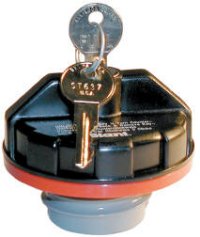 Fuel cap
Fuel cap
- Fuel cell
- A galvanic cell in which the oxidation of a fuel (e.g., methanol) is used to produce electricity.
- A cell that converts chemical energy directly into electric energy, with electric power being produced as part of a chemical reaction between the electrolyte and a fuel such as kerosene or industrial fuel gas.
- An electrochemical power plant (no moving parts) that creates electrical current from hydrogen and oxygen that is passed over a catalyst, usually a microscopically thin sheet of platinum. The electrical current is then fed directly to an electric motor for propulsion. Fuel cells differ from conventional electrical cells in that the active materials such as fuel and oxygen are not contained within the cell but are supplied from outside. It does not contain an intermediate heat cycle, as do most other electrical generation techniques. The only by product of a fuel cell's operation is water, which is pure enough to drink. These cells were first used by NASA in the 1960's for power generation in space capsules. The high price of fuel cell technology has limited the growth of their implementation, but now cells are being used to generate power in hospitals, and to propel vehicles.
- Fuel cock
- A tap which can allow or restrict the flow of gasoline from the gas tank to the carburetor. An essential item on a motorcycle with gravity fed fuel (i.e., no fuel pump) because if the fuel cock is left on after the engine is shut down, there is the possibility that gasoline could leak past the Needle and seat in the carburetor so that the overflow in the float bowl will make its way into the cylinder and wash the walls and dilute the oil
- Fuel computer
- A device which continuously displays the amount of fuel used over the distance since last set.
- Fuel consumption
- The amount of fuel used, expressed in miles per gallon in Britain and the USA, whereas the international measure is litres per 100 kilometres. The US term is fuel mileage.
- Fuel consumption indicator
- An instrument using a Flowmeter to indicate mpg or litres/100 km at any given moment on a journey
- Fuel Control
- Device designed to regulate the fuel supply to the controlled equipment. These may be manual, semi-automatic or automatic.
- Fuel cycle
- The entire set of sequential processes or stages involved in the utilization of fuel, including extraction in its native form, transformation (converting it to a useful product), transportation to market, and combustion (i.e., consuming it at its final destination). Emissions generally occur at each stage of the fuel cycle.
- Fuel distributor
- A device constituting the mixture control unit together with the airflow sensor.
- On Bosch CIS, the device that supplies the injection with pressurized fuel in proportion to air volume, measured by the airflow sensor plate. The fuel distributor houses the control plunger and the differential-pressure valves. All fuel metering takes place inside the fuel distributor
- The component which feeds fuel to the individual engine cylinders corresponding to the air flow rate metered by the air flow sensor on CIS system
- Fuel economy
- The number of litres used per 100 kilometres of driving (a lower number is better); or the number of miles driven divided by the number of gallons used (a higher number is better).
- Fuel efficiency
- Although this factor is similar to fuel economy, it differs in that fuel efficiency involves getting the most amount of energy from an amount of fuel. It answers the question, 'What percent of the fuel does this engine burn?'
- Fuel ethanol
- (C2H5OH) An anhydrous alcohol (ethanol with less than 1% water) intended for gasoline blending as described in the Oxygenates definition.
- Fuel filler flap
- A piece of rubber about 4' square and very thin, which is located behind the filler door. When the door is opened, the flap falls down to protect the body from the fuel nozzle.
- Fuel filler neck
- The upper end of the fuel filler tube leading down to the fuel tank, which accepts the fuel hose nozzle at theGas station
- Fuel filter
- A device that removes impurities (dirt and water) from the fuel before it gets to thecarburetor or injection system. Filters may be made of metal or plastic screen, paper, or gauze. They are usually found near the carburetor in the fuel line that comes from the fuel pump (in-line fuel filter), or inside the carburetor (integral fuel filter) or within the fuel pump or fuel tank. These units must be cleaned or replaced on a regular basis, usually once a year or they will become clogged and restrict fuel to the carburetor. Without a filter, the jets and orifices in the carburetor will become clogged.
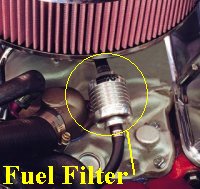 Fuel filter
Fuel filter
- Fuel gas compressor
- A pump or machine for reducing the volume and increasing the pressure of fuel gas.
- Fuel gauge
- An instrument, usually located on the dashboard or center console, which indicates the amount of fuel in thefuel tank. Most gauges have a Needle which fluctuates between E (empty) and F (full). Others show a digital readout of how many gallons or litres left in the tank. Also called gas gauge.
- Fuel-injected engine
- A gasoline engine with a fuel injection system rather than a carburetor.
- Fuel injection
- (FI) A fuel system that uses no carburetor but sprays fuel either directly into the cylinders or into the intake manifold just ahead of the cylinders. It uses an electronic sensing device to deliver the correct amount into the combustion chamber.Throttle-body injection locates the injector(s) centrally in the throttle-body housing, while Port injection allocates at least one injector for each cylinder near its Intake port.
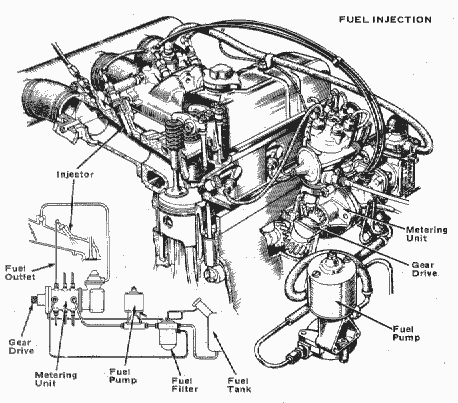 Fuel Injection SystemSee
Fuel Injection SystemSee
- Fuel injection pump
- A pump which receives fuel from the fuel tank (often through the fuel-feed pump in the case of diesel engines) and delivers it under pressure to the injectors
- A pump on diesel engines that sends fuel to its mini-pumps, and from there to the fuel injector nozzles.
- Fuel injector
 Fuel injector
Fuel injector- A special nozzle which sprays the proper amount of gasoline or diesel fuel into the inlet ports, either directly into the combustion chamber or into a pre-chamber in response to signals from an electronic sensing device.
- In all fuel-injection system (except Bosch CIS, CIS/Lambda, and CIS-E systems), a spring loaded, Solenoid (electromagnetic) valve which delivers fuel into the intake manifold, in response to electrical signals from the control module in the CIS, etc. System, the injector is simply a spring-loaded, pressure sensitive valve which opens at a preset value
- Fuel injector nozzle
- The device that works like a hypodermic Needle to inject the proper amount of fuel into the combustion chamber in response to signals from an electronic sensing device on cars with fuel injection systems. It receive fuel at low pressure and shoot it into the engine cylinders at predetermined intervals under higher pressure. Also called fuel injector valve or just fuel injector.
- Fuel line
- The metal, plastic, or rubber hose or pipe through which the fuel passes from the fuel tank to the fuel pump to the carburetor or fuel injector nozzle.
- Fuel metering sensor
- A motor detection device on a carburetor which closes or opens a fuel-metering port to regulate fuel mixture, keeping the air-fuel ratio at exactly 14.61 (stoichiometric) at all times.
 Fuel metering sensor
Fuel metering sensor
- Fuel mileage
- A measurement or calculation of the number of miles per amount of fuel -- usually measured in miles per gallon.
- Fuel mixture
- A mixture of gasoline and air. An average mixture, by weight, would contain 16 parts of air to one part ofgasoline.
- Fuel oil
- Kerosene or any hydrocarbon oil as specified by U.S. Department of Commerce Commercial Standard CS1 2 or ASTM D296, or the Canadian Government Specification Board, 3-GP-28, and having a flash point not less than 38°C.
- A liquid petroleum product less volatile than gasoline, used as an energy source. Fuel oil includes distillate fuel oil (No. 1, No. 2, and No. 4), and residual fuel oil (No. 5 and No. 6).
- The heavy distillates from the oil refining process; used as fuel for power stations and marine boilers.
- Fuel oil types
- There are several designated types of fuel oil such as:
- No. 1 diesel fuel: A light distillate fuel oil that has a distillation temperature of 288°C at the 90-percent recovery point and meets the specifications defined in ASTM Specification D 975. It is used in high speed diesel engines generally operated under frequent speed and load changes, such as those in city buses and similar vehicles. See No. 1 distillate below.
- No. 1 distillate: A light petroleum distillate that can be used as either a diesel fuel: (see No. 1 diesel fuel above) or a fuel oil: (see No. 1 fuel oil: (below).
- No. 1 fuel oil: A light distillate fuel oil that has distillation temperatures of 204°C at the 10-percent recovery point and 288°C at the 90-percent recovery point and meets the specifications defined in ASTM Specification D 396. It is used primarily as fuel for portable outdoor stoves and portable outdoor heaters. See No. 1 Distillate above.
- No. 2 diesel fuel: A distillate fuel oil that has a distillation temperature of 338°C at the 90-percent recovery point and meets the specifications defined in ASTM Specification D 975. It is used in high-speed diesel engines that are generally operated under uniform speed and load conditions, such as those in railroad locomotives, trucks, and automobiles. See No. 2 Distillate below.
- No. 2 distillate: A petroleum distillate that can be used as either a diesel fuel: (see No. 2 diesel fuel above) or a fuel oil: (see No. 2 fuel oil below).
- No. 2 fuel oil: (heating oil) A distillate fuel oil that has a distillation temperature of 338°C at the 90-percent recovery point and meets the specifications defined in ASTM Specification D 396. It is used in atomizing type burners for domestic heating or for moderate capacity commercial/industrial burner units. See No. 2 Distillate above.
- No. 2 fuel oil and No. 2 diesel sold to consumers for all other end uses: Those consumers who purchase fuel oil or diesel fuel for their own use including: commercial/institutional buildings: (including apartment buildings), manufacturing and nonmanufacturing establishments, farms: (including farm houses), motor vehicles, commercial or private boats, military, governments, electric utilities, railroads, construction, logging or any other nonresidential end-use purpose.
- No. 2 fuel oil sold to private homes for heating: Private household customers who purchase fuel oil for the specific purpose of heating their home, water heating, cooking, etc., excluding farm houses, farming and apartment buildings.
- No. 4 fuel oil: A distillate fuel oil made by blending distillate fuel oil and residual fuel oil stocks. It conforms with ASTM Specification D 396 or Federal Specification VV-F-815C and is used extensively in industrial plants and in commercial burner installations that are not equipped with preheating facilities. It also includes No. 4 diesel fuel used for low- and medium-speed diesel engines and conforms to ASTM Specification D 975.
- No. 5 and no. 6 fuel oil sold directly to the ultimate consumer: Includes ships, mines, smelters, manufacturing plants, electric utilities, drilling, railroad.
- No. 5 and no. 6 fuel oil sold to refiners or other dealers who will resale the product: Includes all volumes of No. 5 and No. 6 fuel oil purchased by a trade or business with the intent of reselling the product to the ultimate consumers.
- Fuel petcock
- An on-off valve located at the bottom of a motorcycle fuel tank. It may have a filter screen and sediment bowl and sometimes provides a reserve fuel supply.
- Fuel pressure
- The pressure under which fuel is delivered to the injectors by the fuel pump, governed by the pressure regulator
- Fuel pressure regulator
- A spring-loaded pressure-activated diaphragm valve that maintains the pressure in a fuel system to a pre-set value above manifold pressure, particularly in a fuel injection system and meters unused fuel back to the fuel tank.
 Fuel pressure regulator
Fuel pressure regulator
- Fuel pump
- A vacuum device, operated either mechanically or electrically, that is used to draw gasoline from the tank and sends it into the carburetor or fuel injector nozzles. Mechanical pumps have a Rocker arm that is activated by a cam on the camshaft; the arm causes a diaphragm to move up and down, thus pulling the gas through the pump. Some electrical pumps have a rocker arm which is activated electrically and does the same thing as the mechanical pump. Other electrical pumps are located at the bottom of the fuel tank and push the fuel through the fuel lines.
- Fuel pump filter
- A filter screen built into the fuel pump itself as used on VW Beetles with a mechanical fuel pump.
 VW Fuel pump filter
VW Fuel pump filter - A screw-on canister holding a replaceable pleated paper filter. The canister is mounted onto the base of a fuel pump
 screw-on fuel pump filter
screw-on fuel pump filter
- Fuel pump relay
- An electric switch which activates the fuel pump when the engine is cranked and when the engine is running.
- Fuel pump shut-off switch
- A switch which shuts off the electric fuel pump and fuel to the engine in the event of a major collision
- Fuel pump switch
- A switch which shuts off the electric fuel pump and fuel to the engine in the event of a major collision
- Fuel rail
- A manifold tube feeding the injectors in a fuel injection system. A special manifold designed to provide a large reservoir of pressurized fuel for the fuel injectors, which are attached between the rail and the intake runners or the cylinder head. The fuel rail also serves as a mounting place for the fuel damper (if equipped) and the fuel pressure regulator
- Fuel return line
- A pipe returning surplus fuel to the tank from the carburetor(s) or to the inlet side of the injector pump
- Fuels solvent deasphalting
- A refining process for removing asphalt compounds from petroleum fractions, such as reduced crude oil. The recovered stream from this process is used to produce fuel products.
- Fuel stabilizer
- A chemical which is added to gasoline to prevent it from becoming stale. Gasoline, diesel, or heating fuel reacts with oxygen in the atmosphere and leave behind a varnish-like film or gum residue. While some fuel contains an oxidation inhibitor which allows it to be stored for up to three months, other fuels don't have this inhibitor. Stale gasoline can clog fuel lines, carburetors, and injectors. A good fuel stabilizer can lengthen fuel's useful life.
- Fuel starvation
- The failure of the fuel system to supply sufficient fuel to allow the engine to run properly, due to a blockage or vapor lock or malfunction of the fuel pump.
- Fuel supply
- The delivery of fuel to the carburetor or injection system
- Fuel system
- A system that stores, cleans, and delivers the fuel to the engine in proper quantities to meet the varying needs that arise as you drive. It is made up of the fuel tank, fuel lines, fuel pump, fuel filter, and carburetor or thefuel injection system.
- Fuel tank
- The storage compartment, under the trunk in most cars, that holds the fuel for the vehicle. Also called the gas tank.
 Fuel tank
Fuel tank
- Fuel tank sender
- A level sensor in the gas tank which sends information about the amount of remaining fuel.
- Fuel tank vapor valve
- A valve mounted in the top of the fuel tank. Vents excess vapor and pressure from the fuel tank into the evaporative emission control system
- Fuel utilization
- In fuel cells, the fraction of the fuel or oxidant that enters the cell that reacts electrochemically.
- Fuel-vacuum separator
- Used to filter waxy hydrocarbons from the carburetor ported vacuum to protect the vacuum delay and distributor vacuum controls
- Fuel vapor
- Atomized air/fuel mixture heated in the engine, ready for combustion
- Fumes given off by gasoline
- Fuel vapor recirculation system
- An emission system which traps the excess gasoline vapor, condenses it back to liquid form, and then sends it back to the gasoline tank. Also called evaporative emission control system
- Fuel vapor recovery system
- (FVR) a valve responsible for venting excess fuel vapor and pressure from the fuel system to the EEC system
- Fugitive emissions
- Unintended leaks of gas from the processing, transmission, and/or transportation of fossil fuels.
- Fulcrum pin
- A pin which acts as a pivot, such as a kingpin
- Fulcrum ring
- One of two rings on either side of a Clutch diaphragm spring on which it pivots.
 Fulcrum ringSee
Fulcrum ringSee
- Full Annealing
- Annealing a ferrous alloy by austenitizing and then cooling slowly through the transformation range.
- Full body diameter
- A screw or bolt where the shoulder diameter is the same as the outside or major diameter of the threaded portion.
- Full bore
- A term expressing top speed or full throttle.
- A colloquial term used by vehicle salesmen to express the sale of a vehicle for the full sticker price with no discount.
- Full cam
- A type of camshaft for race car engines which increases lift of valve, speed of valve opening and closing, length of time valve is held open, etc. Also called Race cam, Three-quarter cam, or Semi-race cam, depending upon design
- Full cap
- A condition of retreading where new tread rubber is added to the buffed Casing, and covers the crown and shoulder areas.
- Full-Depth Reclamation
- A special recycling machine grinds up the roadway, up to 6-10' deep, and produces a recycled granular base layer, usually incorporating a liquid asphalt emulsion binder. This layer is then paved with one or more layers of asphalt concrete. The finished driving surface could be an asphalt concrete 'top mix' or a surface treatment. Since this type of work involves up to three or four layers that often require 'curing,' it is usually spread over an 8-12 week period.
- Full dip treatment
- A painting process in which the whole body shell is immersed, used for applying protective Primers
- Full floating
- Mechanism construction in which a shaft is free to turn in all parts in which it is inserted
- Full-floating axle
- A rear drive axle that does not hold the wheel on nor does it hold the wheel in line or support any weight. It merely drives the wheel. Used primarily on racing cars and trucks.See
- Full-flow oil filter
- An Oil filter that filters all of the oil passing through the engine before it reaches the bearings.
- Full leather
- A car interior in which the door trim, instrument panel, seats are covered in leather
- Full leather upholstery
- A car interior in which the door trim, instrument panel, seats are covered in leather
- Full load
- An engine operating conditions where the accelerator is fully depressed, i.e., the throttle is fully open, which does not necessarily mean high engine speedSee
- Full-load current
- The current drawn from the line when the electric motor is operating at full-load torque and full-load speed at rated frequency and voltage
- Full load enrichment
- The provision of a richer mixture when the throttle is fully opened. On some system, the computer goes open-loop during full-load enrichment
- Full load torque
- Maximum torque delivered without overheating.
- The torque necessary to produce the rated horsepower at full-load speed
- Full lock
- A condition in which a detachable component (e.g., seat belt buckles) is securely attached.
- The maximum angle attained by the wheels when the steering wheel is turned to its full extent
- Full panel
- A body part that may be made up of several other subassemblies and is fairly complex and cumbersome, e.g., a complete bulkhead assembly incorporating the windshield pillars
- Full respray
- Painting the entire component or entire vehicle as opposed to a partial respray
- Full service history
- (fsh) The documents which show all the work performed on a vehicle, especially the regular service required by the manufacturer
- Full-Size Body
- The body of a bolt or screw which has a diameter between the minimum and maximum limits of the major diameter of the thread.
- Full-size car
- The largest type of car according to the American system. It is a designation no longer used because even full-size cars are now about the size of what was the compact car. In 1970, for instance, a Chevrolet Impala was a full-size car, a Chevelle was an intermediate, and a Nova was a compact. When cars smaller than the Nova came out (i.e., Chevette), they were called sub-compacts.
- Full-size spare
- A spare wheel and tire combination which is the same size as the rest of the wheels. Compare Space saver spare
- Full-skirt piston
- A former piston style which had a full-annulus skirt, without the cutaway section of modern Slipper pistons
- Full sun
- The full sun condition is the amount of power density received at the surface of the earth at noon on a clear day -- about 1.0 kilowatt/square-metre. Lower levels of sunlight are often expressed as 0.5 sun or 0.1 sun. A figure of 0.5 sun means that the power density of the sunlight is one-half of that of a full sun.
- Full-time 4x4
- A transmission system on a four-wheeled vehicle in which all four wheels are driven by the engine all the time. Other four-wheel drive units are normally in two-wheel drive mode with four-wheel drive selected by a separate lever when required.
- Full-time four-wheel drive
- A condition where all four wheels are always being driven by the drivetrain. It may include the option of part-time (that is, shifting into 2WD for dry pavement) operation, and may or may not have Hi and Lo 4WD speed ranges. The British term is permanent four-wheel drive.
- Full trailer
- A trailer with axles in the front as well as the rear. It can stand without support. Full trailers are coupled to straight trucks and to the rear of semi or full trailers by a tongue or drawbar. Full trailers are seldom used alone with tractors.
- Full Truckload
- A shipment comprising a full or almost full load on a truck. A full or almost full load is considered to be 39,000 to 44,000 pounds.
- Full-wave rectifier
- A rectifier that converts ac to dc by inverting the negative portion of an ac sine wave.See
- Fully electronic ignition
- (FEI) A distributorless, mapped ignition system with cylinder-selective knock control, dwell-angle control, and digital idling speed stabilization
- Fully floating axle
- A live rear axle assembly in which the axle shafts serve only to transmit torque to the wheel. The total vehicle weight and cornering loads are transferred directly from the wheel bearings to the axle housing.
- Fully galvanized body
- A body shell which, except for aluminum and plastic parts, is produced entirely of double-sided galvanized steel and galvanized fasteners or which is immersed in galvanizing fluid
- Functional
- Capable of working even if it is not working to its peak performance.
- Practical, designed not for esthetics; but solely with a particular use in mind
- Funnel
- A cup-shaped object tapering at the bottom to a small hole and a spout, used for pouring oil, fuel, or water into relatively small openings
- A smokestack of a vessel.
- Funny car
- A car equipped with a powerful engine, used for drag racing. Usually has special body (such as Fibreglass) mounted on special lightweight frame and Suspension system.
- Furnace
- A heater or large forge for heating plates or shapes for bending
- To bend by heating in furnace.
- Furnace, central warm air
- Self-contained appliance designed to supply heated air through ducts to spaces remote from or adjacent to the appliance location.
- Fuse
- A protective electrical device (usually enclosed in glass or plastic) which has a thin wire between two terminals. The wire will break or melt when the current draw exceeds the capacity of the fuse. In this way, the circuit is protected from overload.
- The action of melting when a piece of metal turns to a liquid state and sometimes unites itself to a nearby component.
- A failure of an electrical component because of a blown fuse.
- Fuse box
- A container with a removable cover that holds the fuses for the various electrical circuits, which are all routed through it
- Fuse capacity
- See
- fuse.
- Fusible link
- Special length of smaller gauge wire designed to blow if heavy current flows in circuit
- A wire in the electrical system which outwardly may appear to be no different from other wires, but has a low resistance level so that when the current is above a certain level, the wire melts and breaks continuity.
- Fusible plug
- Plug or fitting made with a metal of a known low-melting temperature. Used as safety device to release pressures in case of fire.
- Fusion fit
- The Adjustable Retention System extending behind a Bell bicycle helmets to allow the helmet to grip your head better.
-
- FVR
- Abbreviation for Fuel vapor recovery system
- FWD
- Abbreviation for Front-wheel drive
- g
- A unit of measurement for lateral acceleration, or road-holding. One g is equivalent to 981 cm (32.2 feet) per second every second, the rate at which any object accelerates when dropped at sea level. If a car were cornering at 1.0 g -- a figure that very few production cars are able to approach -- the driver's body would be pushing equally hard against the side of the seat as against the bottom of it. Most fast sedans accelerate about 0.8 g.
- G7
- Seven industrial countries consisting of the United States, Japan, Germany, France, the United Kingdom, Italy and Canada, whose leaders have met at annual economic summits since 1975 to coordinate economic policies.
- Gage
- A standard SAE designation of wire sizes, expressed in AWG (American Wire Gage). The larger the gage number, the smaller the wire. Metric wire sizes are expressed in cross-sectional area, which is expressed in square millimetres. Sometimes the spelling gauge is also used to designate wire size. However, it is becoming standard to use gage for wire size and gauge for instruments. Americans often use gage for instruments.
- Gal.
- Abbreviation for gallon. A US gallon (3.78543 litres) (231 cubic inches) is 20% smaller than an Imperial gallon (4.54609 litres).
- GALFAN®
- A trademark for a special type of hot-dip galvanized steel sheet with a coating consisting of a zinc alloy containing 5% aluminum and rare earths
- Gallery
- A channel or tube usually found within the engine block for the transfer of fluid or gas.
- Galling
- A condition that takes place when two metals or fasteners stick together and cannot be easily loosened. In tightening fasteners, for example, pressure builds on threads as metals rub against each other, and the passive film preventing corrosion on stainless may not form due to lack of oxygen. Also called seizing
- Developing a condition on the live bearing surface of a pin or bushing of a chain where excessive friction between high spots results in localized welding with subsequent tearing and a further roughening of the contact surfaces.
- Gallon
- A US gallon (3.785 litres) is 20% smaller than an Imperial gallon (4.546 litres).
- Galvalume®
- Trademark for a special type of hot-dip galvanized steel sheet with a coating consisting of 55% aluminum, 43.4% zinc and 1.6% silicon
- Galvanic action
- Wasting away of two unlike metals due to electrical current passing between them. The action is increased in the presence of moisture.
- Galvanic cell
- Cell which converts chemical energy into electrical energy by irreversible chemical reactions
- Galvanic corrosion
- Corrosion due to the action of a galvanic cell.
- An accelerated degree of corrosion occurring when two different metals are in contact with moisture, particularly sea water. All metals have what is termed a specific electric potential, so that low level electric current flows from one metal to another. A metal with a higher position in the galvanic series will corrode sacrificially rather than one with a lower position, meaning stainless, for example, will corrode before gold. The further apart the metals on the chart, the more electric current will flow and the more corrosion will occur. No serious galvanic action will occur by combining the same metals, only dissimilar ones. To prevent galvanic corrosion, use insulation, paint, or coatings when separating dissimilar metals; or put the metal to be protected next to a metal which is not important in the assembly, so it can corrode sacrificially. Metals listed first will corrode due to galvanic reaction before those at end of paragraph: magnesium, zinc, aluminum 1100, cadmium, aluminum 2024, steel and iron, lead, tin brass, copper, bronze, monel, 304 and 316 stainless (passive), silver, titanium, graphite, gold.
- Galvanize
- The action of plating with zinc and/or lead by hot dipping or electrodeposition to protect from rust.
- Galvanize differentially
- The action of obtaining different coating thicknesses on the two sides of the sheet of iron.
- Galvanizing
- The application of zinc coatings on the surface of a metal, by hot dipping or electrodeposition to protect from rust.
- Galvanizing bath
- A bath for hot-dip galvanizing or Electrogalvanizing
- Galvanometer
- An instrument used to measure the pressure, amount of, and direction of an electric current.
- Gamma layer
- Part of the zinc-iron alloy layer on hot-dip galvanized iron and steel containing 21-28% iron
- Gangway
- A narrow hanging staircase or ladder used by persons entering or leaving a vessel from the pier or boat. Also see Fore And Aft Gangway
- Gantry
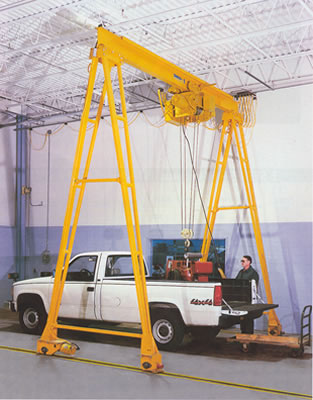 Gantry
Gantry- A structure with an overhead beam, used for lifting out an engine. Compare Engine hoist.
- Overhead steel structures across the highway to hold up a traffic sign
- Gap
- The distance between the center terminal (electrode) and the outer terminal (electrode) through which the spark must travel in a spark plug.See
- The distance between the points in contact breaker points.See
- The distance between two vehicles traveling down the road as they go in the same direction. Generally a safe distance is a minimum of two seconds behind the vehicle in front.
- The distance between the two ends of piston rings.
- The distance between the center terminal (electrode) and the outer terminal (electrode) through which the spark must travel in a spark plug.
- Gap bridging
- A formation of carbon or other deposits across the Spark plug gap which shorts out the plug
- Gap insurance
- This covers you against additional losses not covered by your auto insurance in the case of an accident in which the vehicle is totaled. Most auto insurance will cover the actual cash value of the vehicle and what is owed on the lease contract, including early termination fees. Gap insurance is most important in the early years of a lease when the difference between the value of the car and what is owed are greatest. Some manufacturers now include Gap insurance in their leases.
- Gapping
- Adjusting the distance between the electrodes of a spark plug or the points of contact breaker points.See
- Gap Tooth Sprocket
- An even number tooth sprocket designed with clearance for a through rod or saddle. D-5 or GK1 attachment chains are used on this style sprocket.
- Garage
- A building in which a motor vehicle is kept.
- The premises on which motor vehicles are repaired or serviced and/or where fuel is sold.
- To keep in a garage
- Garaged
- A reference to a vehicle which is kept in a garage, as in My car is always garaged. The abbreviation in advertisements is gar'd.
- Garbage
- Trucker slang for produce (bananas, lettuce etc.) as in 'I sure am glad I'm not takin' this load of garbage to Hunt's Point.'
- A cargo body style typified by garbage trucks that often have hydraulic packing mechanisms or hydraulic arms for lifting dumpsters. Included are roll-offs, vehicles used for transporting refuse containers. Roll-offs have rails or a flat bed and a hoist for loading and unloading the refuse container.
- Garbage Cargo
- A cargo body style typified by Garbage trucks that often have hydraulic packing mechanisms or hydraulic arms for lifting dumpsters. Included are roll-offs, vehicles used for transporting refuse containers. Roll-offs have rails or a flat bed and a hoist for loading and unloading the refuse container.
- Garbage truck
- A cargo body style often with hydraulic packing mechanisms or hydraulic arms for lifting dumpsters. Included are roll-offs, vehicles used for transporting refuse containers. Roll-offs have rails or a flat bed and a hoist for loading and unloading the refuse container. Also called refuse truck
- Garbage wagon
- A scornful term used by some outlaw bikers to describe a Touring motorcycle
- Garboard strake
- The strake of bottom shell plating adjacent to the keel plate. The course of plates next to the keel of a ship.
- Garnish molding
- The upper molding or trim on a door panel used to retain the door trim panel to the door assembly or to ornament the interior window frames.
- Garnish rail
- Trim moldings on doors, usually to ornament interior window frames. Also called garnish trim.
- Garnish trim
- See Garnish rail
- Gas
- A vapor having no particles or droplets of liquid. In physics, a gas is a substance which possesses perfect molecular mobility and, unlike a liquid or a solid, the ability to expand indefinitely
- A non-solid material. It can be compressed. When heated, it will expand; and when cooled, it will contract (such as air.)
- A common term for gasoline. The British term is petrol.See
- A term for LPG or Propane.
- A term referring to the exhaust gases.
- A non-solid, non-liquid combustible energy source that includes natural gas, coke-oven gas, blast-furnace gas, and refinery gas.
- Fuel gas, such as natural gas, undiluted liquefied petroleum gases (vapor phase only), liquefied petroleum gas-air mixtures, or mixtures of these gases.
- To apply the throttle.
See- Associated-Dissolved Natural Gas
- Biomass Gas
- Delivered Gas
- Dry Natural Gas
- exhaust Gases
- Flash Gas
- Greenhouse Gases
- Hot Gas
- Landfill Gas
- Liquefied Natural Gas
- Liquefied Petroleum Gas
- Liquefied Refinery Gases
- Low BTU Gas
- Manufactured Gas
- Native Gas
- Natural Gas
- Nonassociated Natural Gas
- Noncondensable Gas
- Nonhydrocarbon Gases
- Non-Methane Organic Gases
- Processed Gas
- Radiatively Active Gases
- Refinery Gas
- Reformate Gas
- Residual Exhaust Gases
- Residue Gas
- Salable Natural Gas
- Sour Gas
- Still Gas
- Sweet Gas
- Synthetic Natural Gas
- Unprocessed Gas
- Vent Gases
- Wet Natural Gas
- Gas burner
- Competition vehicle with engine set up to operate on standard pump gasoline instead of an alcohol, nitro, etc., mixture. Also called gasser.
- Gas cap
- A vented covering on the top of the tube leading to the fuel tank. Also called fuel cap.
 Gas cap
Gas cap
- Gas charged shock absorbers
- A damper that uses pressurized gas, such as nitrogen, to help prevent changes in damping as the damper heats up.
- Gas discharge headlight
- A motor vehicle headlight with a gas discharge lamp
- Gaseous discharge headlight
- A Gas discharge light
- Gases in Bulk
- These are carried in pressurized tankers only, and are not otherwise containerized. Examples: Aerosol propellant, butane, CO2, LPG, nitrogen, and propane.
- Gases in Bulk cargo
- These are carried in pressurized tankers only, and are not otherwise containerized. Examples: Aerosol propellant, butane, CO2, LPG, nitrogen, and propane.
- Gas fade
- Brake fade caused by hot gases and dust particles that reduce friction between the brake linings and drum or rotor under hard, prolonged braking
- Gas filter
- A device for screening the gasoline to remove the impurities.See
- Gas forced-air heat pipe
- High efficiency gas furnace that uses vertical liquid filled pipes. The pipes are heated by a burner at their base, and the liquid boils and vaporizes within the pipe. The furnace blower circulates air over the pipes for heating.
- Gas gauge
- An instrument, usually located on the dashboard or center console, which indicates the amount of fuel in thefuel tank. Most gauges have a Needle which fluctuates between E (empty) and F (full). Others show a digital readout of how many gallons or litres left in the tank. Also called fuel gauge.
- Gasification
- A method for converting coal, petroleum, biomass, wastes, or other carbon-containing materials into a gas that can be burned to generate power or processed into chemicals and fuels.
- Gasket
- A material made of asbestos, cardboard, cork, paper, rubber, treated fiber, or soft metal like aluminum or copper placed between two metal parts to insure proper sealing.
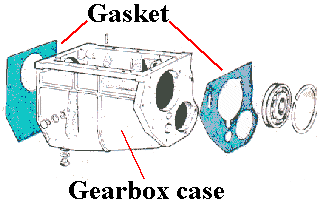 Gasket
Gasket
- Gasket scraper
- A scraper with a sharp chisel edge for removing old gasket material from a surface before installing a new gasket.
 Gasket scraper
Gasket scraper
- Gas metal-arc welding
- Welding using a continuously fed consumable electrode and a shielding gas. Also called sigma welding.
- Gas, noncondensable
- Gas which will not form into a liquid under the operating pressure-temperature conditions.
- Gasohol
- A blend of gasoline and ethanol alcohol or methanol that usually is 90 to 94.3% gasoline and 5.7 to 10% ethanol. This term was used in the late 1970s and early 1980s but has been largely replaced by terms such as E10, Super Unleaded Plus Ethanol or Unleaded Plus Ethanol. Ethanol is the alcohol found in intoxicating beverages. It may attack rubber and plastic parts of fuel systems not designed to handle alcohol-blended fuels, but it is not poisonous to human beings like wood alcohol or methanol.
- Gasoline
- A Hydrocarbon fuel used in an internal combustion engine. Gasoline is refined from crude oil which is made up of fossilized plant and animal remains. In Britain it is called petrol.See
- Aviation Gasoline
- Casing Head Gasoline
- Ethyl gasoline
- Lead-free gasoline
- Leaded gasoline
- Leaded Premium Gasoline
- Midgrade Gasoline
- Motor Gasoline
- Natural Gasoline
- Oxygenated gasoline
- Premium gasoline
- Pump gasoline
- Purple Gasoline
- Reformulated gasoline
- Regular gasoline
- Regular Grade Gasoline
- Unleaded gasoline
- Unleaded Midgrade Gasoline
- Unleaded Premium Gasoline
- Unleaded Regular Gasoline
- Gasoline blending components
- Naphthas which will be used for blending or compounding into finished aviation or motor gasoline (e.g., straight-run gasoline, Alkylate, Reformate, Benzene, Toluene, and Xylene). Excludes oxygenates (alcohols, ethers), Butane, and Pentanes plus
- Gasoline grades
- The classification of gasoline by octane ratings. Each type of gasoline (conventional, oxygenated, and reformulated) is classified by three grades - Regular, Midgrade, and Premium. Note: Gasoline sales are reported by grade in accordance with their classification at the time of sale. In general, automotive octane requirements are lower at high altitudes. Therefore, in some areas of the United States, such as the Rocky Mountain States, the octane ratings for the gasoline grades may be 2 or more octane points lower.
- Regular gasoline: Gasoline having an antiknock index, i.e., octane rating, greater than or equal to 85 and less than 88. Note: Octane requirements may vary by altitude.
- Midgrade gasoline: Gasoline having an antiknock index, i.e., octane rating, greater than or equal to 88 and less than or equal to 90. Note: Octane requirements may vary by altitude.
- Premium gasoline: Gasoline having an antiknock index, i.e., octane rating, greater than 90. Note: Octane requirements may vary by altitude.
- Gasoline pump
- A device which pulls fuel from an underground storage tank into a vehicle's gas tank.
- Gas pedal
- The device actuated by the operator's foot for increasing or decreasing the amount of fuel entering thecombustion chamber. Also called throttle pedal or accelerator.
- Gas pump
- A device at a service station which pulls gasoline from a storage tank (usually located underground) into the vehicle's gas tank. Commercial units also record the amount of fuel dispensed as well as the cost. The British term is petrol pump.
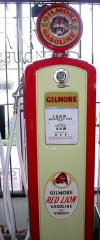 Gas pump
Gas pump
- Gasser
- A vehicle which burns normal gasoline instead of racing fuel.See
- Gassing
- The small hydrogen bubbles rising to the top of the battery electrolyte during Battery charging.
- Gas spring
- A pressurized, nitrogen-filled sphere, used in Hydragas and hydropneumatic suspension systems
- Gas station
- A place where gasoline is dispensed. British term is Petrol station.
- Gas tank
- The container for holding or storing fuel. Also called fuel tank. Also see Liquid Gas Tank.
 Gas tank
Gas tank
- Gas to liquid
- (GTL) A process that combines the carbon and hydrogen elements in natural gas molecules to make synthetic liquid petroleum products, such as diesel fuel.
- Gas turbine
- An internal-combustion rotating engine with one main moving part therotor with pinwheel-like blades attached. Air is compressed by the first rows of blades and delivered to the combustion chambers, from which the exhaust is directed to pass the remaining blades and to generate the power. Power is extremely smooth due to the absence of explosions andReciprocating parts.
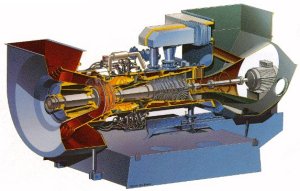 Gas Turbine
Gas Turbine
- Gas vent
- A passageway, composed of listed factory-built components assembled in accordance with the terms of listing, for conveying flue gases from gas utilization equipment or their vent connectors to the outside atmosphere.
- Gas welding
- A welding process widely used in body repair shops (now being gradually replaced by MIG welding). Also called oxyacetylene welding.
- Gate
- The slotted guide for the Gearshift of an internal combustion engine.
- The slotted guides in a shift drum.
- A tailgate.
- A circuit in which one signal, generally a square-wave, serves to switch another signal on and off.
- Gateway
- The point at which freight is interchanged/interlined between carriers or at which a carrier joins two operating authorities provision of through service.
- GATT
- Abbreviation for General Agreement on Tariffs and Trade.
- Gauge
- This is the British and Canadian spelling while in the United States it is sometimes spelled without the u(gage). It is becoming standard to use gage for wire size and gauge for an instrument.
- An instrument or meter that registers the quantity of a substanceSee
- Ammeter
- Auxiliary Gauge
- Boost gauge
- Bowden Gauge
- Fuel gauge
- Gas gauge
- Hydrostatic Gauge
- In-dash gauge
- Low-pressure Gauge
- Low Side Gauge
- Oil gauge
- Oil level gauge
- Oil pressure gauge
- Oil temperature gauge
- Outdoor Temperature Gauge
- Outside temperature gauge
- Pounds Per Square Inch Gauge
- Temperature gauge
- Turbo gauge
- Vacuum gauge
- Voltmeter
- Water temperature gauge
- A tool for measuring Clearances, pressures, sizes, etc.See
- Adjusting gauge
- B & S gauge
- Beta Thickness Gauge
- Birmingham Gauge
- Birmingham Wire Gauge
- Bridge Gauge
- Standard Wire Gauge
- Broad Gauge
- Brown and Sharpe Wire Gauge
- Buckley Gauge
- Caliper gauge
- Compression gauge
- Compression tester
- Depth gauge
- Dial gauge
- Disc brake gauge
- Draft Gauge
- Feeler gauge
- Frame gauge
- High-pressure Gauge
- Ignition gauge
- Micron Gauge
- Pressure Gauge
- Screw pitch gauge
- Sighting point gauge
- Spark plug gauge
- Step Feeler Gauge
- Throttle gauge
- Tire gauge
- Tire pressure gauge
- Tram gauge
- Tread depth gauge
- Vernier gauge
- Wheel alignment gauge
- A measurement of tubing.
- An instrument or meter that registers the quantity of a substance
- Gauge box
- A container which measures a known quantity of material such as cement, sand, or rocks for testing or making mixtures
- Gauge, high-pressure
- Instrument for measuring pressures in range of 0 psia to 500 psia (101.3 kPa to 3600 kPa).
- Gauge, low-pressure
- Instrument for measuring pressures in range of 0 psia to 50 psia 10 kPa to 350 kPa.
- Gauge, manifold
- Chamber device constructed to hold both compound and high-pressure gauges. Valves control flow of fluids through it.
- The one essential diagnostic tool required for every air conditioner service procedure. A typical gauge set includes high and low side gauges and valves for checking, measuring and controlling pressure and vacuum, and a third valve for controlling discharging, evacuation and charging procedures. Also calledgauge set
- Gauntlet
- A long-sleeved leather glove used by motorcyclists to prevent wasps from flying up the sleeve, as one did to me.
- Gauss
- A measure of magnetic flux density. In the centimetre-gram-second electromagnetic system it is one maxwell per square centimetre, where a maxwell (line) is a unit of magnetic flux. The magnetic flux density at the surface of the earth is about one-half gauss. At a magnetic pole of an electric motor the magnetic flux density is about 8000 gauss.
- GAWR
- Abbreviation for Gross Axle Weight Rating -- Maximum weight an axle is rated to carry by the manufacturer. Includes both the weight of the axle and the portion of a vehicle's weight carried by the axle.
- Gaylord
- A vehicle brand of which the 1955-57 models are milestone cars.
- Large corrugated carton that has the same length and width as a pallet. Gaylords are usually used to protect loose parts in bulk and are frequently used in manufacturing.
- G-clamp
- A screw-activated clamping device in the shape of the letter G
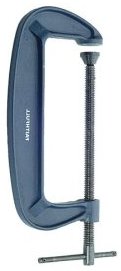 G-clamp
G-clamp
- GCW
- Abbreviation for Gross combination weight. Total weight of a loaded combination vehicle, such as a tractor-semitrailer or truck and full trailer(s).
- GCWR
- Abbreviation for Gross Combined Weight Rating
- GDC
- Abbreviation for Fuel Data Center
- GDP
- Abbreviation for Gross domestic product
DICTIONARY OF AUTOMOTIVE TERMS - 'Ge'
- Gear
- Wheel-like part with teeth cut into the rim. When one gear meshes with another gear, it causes the second gear to drive the other and in this way transmits power. When the gears are different sizes (different number of teeth on each gear) the mechanical average is changed.
 GearSee
GearSee- Annular Gear
- Axle end gears
- Back Gear
- Barring Gear
- Beaching Gear
- Bevel gear
- Bottom gear
- Brush Gear
- Camshaft gear
- Center gear
- Change gear
- Cluster gear
- Constant mesh gears
- Crankshaft gear
- Crawler gear
- Differential gears
- Differential side gear
- Distributor Drive Gear
- Double helical gear
- Drive gear
- Driven gear
- Driving gear
- Economy gear
- EP gear oil
- Epicyclic Gear
- Fifth gear
- Final drive gear
- First gear
- Fixed gear
- Flywheel ring gear
- Fourth gear
- Granny gear
- Helical gear
- Herringbone gears
- High gear
- Hypoid gear
- Hypoid gear oil
- Idler gear
- Intermediate gear
- Internal gear
- Internal gear pump
- Landing Gear
- Left hand gear lever
- Low gear
- Mating gears
- Member of the gear train
- Overall gear ratio
- Passing gear
- Pinion gear
- Planetary gear
- Planetary gear differential
- Planetary gear set
- Planet gears
- Reverse gear
- Reverse idler gear
- Reversible gear puller
- Ring gear
- Running gear
- Second gear
- Shift gear
- Sliding gear
- Spider gear
- Spiral bevel gear
- Spur gear
- Starter ring gear
- Steering gear
- Stepped planet gear
- straight-cut gear
- Sun gear
- Third gear
- Timing gear
- Top gear
- Valve gear
- Wide-step gearing
- Worm gear
- Gearbox
- The device in the Drivetrain consisting of an Input shaft, a system of gears, and an Output shaft that multiplies engine torque. A manual transmission consists of a clutch assembly plus a gearbox; and automatic transmission generally consists of a Torque converter plus gearbox.See
- Accessory Gearbox
- automatic gearbox
- Auxiliary gearbox
- Change-speed gearbox
- Close-ratio gearbox
- Constant mesh gearbox
- Cotal gearbox
- Crash gearbox
- Dual-range gearbox
- Epicyclic gearbox
- Four-speed gearbox
- manual gearbox
- Planetary gearset
- Pre-selector gearbox
- Rack and pinion gearbox
- Reduction gearbox
- Sliding-mesh gearbox
- Steering gearbox
- Wilson gearbox
- Gearchange cables
- British term for Shift cables used to operate gears in some transmissions. In most vehicles rods and joints are used because cables tend to stretch.
- Gearchange linkage
- A system of rods and joints used to operate the gearbox. British term for Shifter linkage
- Gearchange mechanism
- A system of rods and joints used to operate the gearbox. British term for Shifter mechanism
- Geared Speed
- The calculated vehicle speed at the engine's governed rpm in each transmission gear, or (commonly) in top gear.
- Gear grease
- A heavy liquid Grease that fills the differential and manual transmission to lubricate the gears. Also calleddifferential grease.
- Gearhead
- A person with a strong interest in all things mechanical
- The portion of a gearmotor which contains the actual gearing that converts the basic motor speed to the rated output speed
- Gear indicator
- A display which shows the particular transmission gear that has been selected.
- Gearing
- The combination or system of gears or sprockets designed to transmit power.
- The ratio between the drive gear and the driven gear.
- Gearjammer
- Trucker slang for a speeding trucker as in 'We got us a real gearjammer in that eastbound lane.'
- Gear knob
- British term for the knob at the end of a lever, i.e., Shifter knob
- Gear lever
- A device which is attached to the side of a steering column or to the center console which will allow the operator to change the gears of the transmission. Also called shift lever.
- Gear oil
- A heavy oil which is rated at 80 to 100 weight Viscosity used in enclosed units containing gears. This oil infrequently or rarely needs changing.See
- Gear puller
- A tool with two or more jaws and pressure screw for pulling off gears, bearings, pulleys, etc.
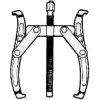 Gear puller
Gear puller
- Gear pulser
- A term used by some manufacturers, including Subaru, for the Tone rings
- Gear range
- Choice of gears in an automatic transmission. The typical gear ranges are P - Park, R - Reverse, N - Neutral, D -Drive, L - Low
- Gear ratio
- The relationship between the number of turns made by a driving gear to complete one full turn of the driven gear. If the driving gear turns four times to turn the driven gear once, the gear ratio would be 4 to 1. In most instances, the gear ratio is not even like 4:1 because the same teeth would be meshing with each other frequently. Thus a ratio of 4.11:1, for instance, means that a particular tooth on one gear would take a much longer time (i.e., more revolutions) to mate with the same tooth on the other gear. Changing the tire size will change the effective gear ratio.
- A number, usually expressed as a decimal fraction, representing how many turns of the input shaft cause exactly one revolution of the output shaft. Applies to transmissions, power takeoffs, power dividers and rear axles. Example If 2.5 revolutions of an input shaft cause one revolution of the output shaft, the gear ratio is 2.5:1.
- Gear reduction
- Setup in which a small gear is used to drive a larger gear. Produces an increase in torque.
- Gear selector
- The device (e.g., lever or rod or pushbutton) for choosing the desired automatic transmission gear. Located on the side of the steering column, in a console, or on the floor between the front seats.See
- Gear selector indicator
- An indicator positioned in the instrument cluster or on the center console shift gate indicating which gear has been selected in an automatic transmission
- Gearshift
- A device which allows the operator to move the transmission gears into various configurations. Most often the gearshift is located on a lever on the Steering column or on a lever on the floor between the driver and front passenger. Some older Chryslers had Pushbutton controls on theDash. On motorcycles, the shift lever is located on the left or right side and operated by the foot.
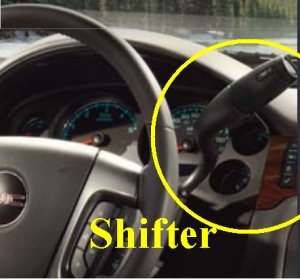 Gearshift
Gearshift
- Gearshifter
- A device which allows the operator to move thetransmission gears into various configurations. Most often the gearshift is located on a lever on the Steering column or on a lever on the floor between the driver and front passenger. Some older Chryslers had Pushbutton controls on the Dash. On motorcycles, the shift lever is located on the left or right side and operated by the foot.
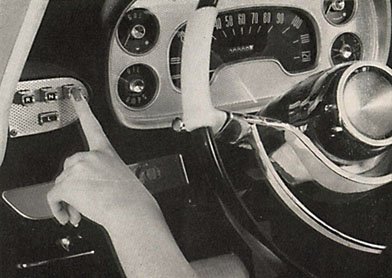 Gearshifter
Gearshifter
- Gearslammer
- Trucker slang for a trucker who's known to accelerate and decelerate a lot as in 'Better watch out there's a real gearslammer in the granny lane.'
- Gearstick
- A British term for the stick used by the driver to change gears. Also called a shifter or shift lever.
- Gear-type oil pump
- The simplest oil pump with two gear wheels. Compare Rotor-type oil pump.
 Gear-type oil pump
Gear-type oil pump
- Gel cell battery
- A battery where the acid is in the form of a gel so that in the event of a spill, acid does not leak out -- especially recommended for electric mobility scooters and power wheelchairs
- Gel coat
- A thin layer of plastic resin covering fiberglass panels.
- An outer layer of GRP (glass reinforced plastic) moldings which gives a smooth surface that may be colored
- Gel-coat resin
- A resin similar to general lay-up resin but with an additive to make it thixotropic, i.e., it does not run down vertical surfaces; used to make the gel coat in moldings
- General Agreement on Tariffs and Trade
- (GATT) Signed in 1947, the GATT was a formal multilateral agreement aimed at expanding and liberalizing world trade. The World Trade Organization which is the successor to the GATT came into existence on January 1, 1995.
- General corrosion
- In contrast to pitting, a type of corrosion which affects the entire surface of a metal
- General Freight cargo
- Processed items, packaged or in some way containerized, and fairly closely packed.
- Generalized Preferential Tariff
- (GPT) system of non-reciprocal tariff preferences for the benefit of developing countries. It grants duty-free or preferential entry to imports for eligible developing countries up to a certain dollar value or import percentage limit.
- General mess of crap
- Trucker slang for GMC trucks by Volvo/White as in 'I used to drive a general mess of crap.'
- General Motors
- (GM) or (GMC) The largest American vehicle manufacturer including: It has subsidiaries and associates in Britain (Vauxhall), European continent (Opel, Fiat, and Saab), Australia (Holden), Asia (Subaru, Fuji,Suzuki)
- General purpose lacquer thinner
- A type of thinner that may be used for both lacquers and synthetic enamels without causing lifting or other paint faults
- General repair manual
- Service manual that covers many models. Often not published by the specific model manufacturer.
- Generator
- A mechanism which generates or produces some substance, i.e., electric generator, acetylene generator.
- A device which converts mechanical energy into electrical energy, producing direct current (dc).
- An Electromagnetic device for producing Direct current electricity. It was replaced by an Alternator in the early '60s. Its problem was that a generator Recharged the battery only at high speeds. The British call it a dynamo.
- Generator capacity
- The maximum output, commonly expressed in megawatts (MW), that generating equipment can supply to system load, adjusted for ambient conditions.
- Generator nameplate capacity
- The maximum rated output of a generator under specific conditions designated by the manufacturer. Generator nameplate capacity is usually indicated in units of kilovolt-amperes (kVA) and in kilowatts (kW) on a nameplate physically attached to the generator.
- Genset
- Abbreviation for Generator set, a generating system comprising a combustion engine driving an electrical generator.
- Geo
-
A model of automobile manufactured by Suzuki for GM including the following models Metro (1989-97), Prizm (1989-97), Spectrum (1988-89), Storm (1990-93), Tracker (1989-97)
- Geographic Information System
- (GIS) A system of information, organized in layers that can be applied to a specific geographic location to such things as population density, traffic volume, business development, etc.
- Georges Irat
- A vehicle of which models built between 1925 and 1948 are classic cars
- Georgia overdrive
- Trucker slang for neutral gear as in 'You put her in Georgia overdrive on the downstroke.'
- Getting out
- Trucker slang for being heard on the CB as in 'Can anyone tell me if my CB is getting out?'




No comments:
Post a Comment